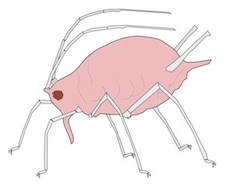Nancy A. Moran
Research
CURRENT RESEARCH
PAST RESEARCH
- Elucidating the molecular bases of species interactions in host-associated bacterial communities
- Role of Gut Microbiota in Honey Bee Health
- Coevolutionary dynamics in an obligate insect symbiosis
- Colonization by a Co-evolved Gut Community
- Dual Obligate Intracellular Symbionts
- Control of Bee Behavior by Stably Engineered Gut Microbial Communities
- Dimensions of Biodiversity: the Gut Microbiota of Bees
- Environmental Genomics of Symbionts in Pea Aphids
- Genomics of Bacterial Symbionts of Plant Sap-Feeding Insects
- Biocomplexity in the Environment
- Bacterial Endosymbiont Diversity in Drosophilla
- Biocomplexity of Symbiotic Bacteria
- Genomic Evolution of Buchnera
- Evolutionary Dynamics of Endosymbiont-Borne Adaption on Aphids
- Molecular Phylogenetics of Sternorrhyncha
- Phylogenetics of Aphids
- Genetically Variable Complex Life Cycles in Heterogeneous Environments
PAST Research Projects

Elucidating the molecular bases of species interactions in host-associated bacterial communities
(PI is Nancy Moran)

 Microbial communities exert major impacts on animal biology and human health, and disruption of these communities is associated with multiple disease states. To date, the field of microbiome research has been dominated by surveys of microbial community compositions and by analyses correlating composition with host phenotypes. But there have been few attempts to directly link the specific, causal processes that determine colonization dynamics and success of host-associated bacteria, and how these interactions ultimately affect hosts. The proposed research plan is motivated by the need for experimental systems to identify the mechanisms that control the composition and consequences of host-associated bacterial communities. This work focuses on two model systems that provide complementary approaches to examining host-associated communities, and that offer new opportunities to identify the mechanisms underlying host colonization. The honey bee and its specialized gut microbiota provides an exceptional model for multispecies gut communities as it shares many features with the human gut microbiota. In both human and bee guts, a stable, healthy community bestows “colonization resistance”, the exclusion of foreign microorganisms; in both systems, disruption can result in dysbiosis and expansion of atypical communities, including enteric pathogens. The human system is highly complex and not amenable to experiments, but, for the bee gut, we are able to culture isolates of all component bacterial species and to introduce these to microbiota-free hosts to establish defined communities. We have already developed genetic tools for experimental manipulation of the dominant species. One set of experiments will identify the direct host-bacterial interactions that determine colonization success or failure of particular strains that vary in ability to colonize honey bees. Existing results from a mutagenesis screen indicate that features of the outer cell envelope play essential roles during host colonization, and we will use new genetic tools to determine which of these factors are key to acceptance by hosts. In addition to elucidating the mechanisms that enable specific bacterial strains to mono-colonize specific hosts, a second set of experiments will investigate how the interactions between microbial strains, which range from metabolic co-dependency to direct toxin-mediated antagonism, determine community membership. The pea aphid and its endosymbionts provide an effective model for how intracellular bacterial associates stably colonize host cells. Our newly devised techniques allow isolation, manipulation and inter-host transfer of endosymbionts. To address how hosts control endosymbiont replication and persistence, we will perform genomic comparisons, biochemical experiments to test effects of host-produced gene products on endosymbiont cells, and physical and structural characterization of endosymbiont outer membrane proteins. Through focus on experimental models that provide tractable examples of host-associated bacteria, this work will illuminate the mechanisms that underlie ability of bacterial symbionts to colonize hosts.
Microbial communities exert major impacts on animal biology and human health, and disruption of these communities is associated with multiple disease states. To date, the field of microbiome research has been dominated by surveys of microbial community compositions and by analyses correlating composition with host phenotypes. But there have been few attempts to directly link the specific, causal processes that determine colonization dynamics and success of host-associated bacteria, and how these interactions ultimately affect hosts. The proposed research plan is motivated by the need for experimental systems to identify the mechanisms that control the composition and consequences of host-associated bacterial communities. This work focuses on two model systems that provide complementary approaches to examining host-associated communities, and that offer new opportunities to identify the mechanisms underlying host colonization. The honey bee and its specialized gut microbiota provides an exceptional model for multispecies gut communities as it shares many features with the human gut microbiota. In both human and bee guts, a stable, healthy community bestows “colonization resistance”, the exclusion of foreign microorganisms; in both systems, disruption can result in dysbiosis and expansion of atypical communities, including enteric pathogens. The human system is highly complex and not amenable to experiments, but, for the bee gut, we are able to culture isolates of all component bacterial species and to introduce these to microbiota-free hosts to establish defined communities. We have already developed genetic tools for experimental manipulation of the dominant species. One set of experiments will identify the direct host-bacterial interactions that determine colonization success or failure of particular strains that vary in ability to colonize honey bees. Existing results from a mutagenesis screen indicate that features of the outer cell envelope play essential roles during host colonization, and we will use new genetic tools to determine which of these factors are key to acceptance by hosts. In addition to elucidating the mechanisms that enable specific bacterial strains to mono-colonize specific hosts, a second set of experiments will investigate how the interactions between microbial strains, which range from metabolic co-dependency to direct toxin-mediated antagonism, determine community membership. The pea aphid and its endosymbionts provide an effective model for how intracellular bacterial associates stably colonize host cells. Our newly devised techniques allow isolation, manipulation and inter-host transfer of endosymbionts. To address how hosts control endosymbiont replication and persistence, we will perform genomic comparisons, biochemical experiments to test effects of host-produced gene products on endosymbiont cells, and physical and structural characterization of endosymbiont outer membrane proteins. Through focus on experimental models that provide tractable examples of host-associated bacteria, this work will illuminate the mechanisms that underlie ability of bacterial symbionts to colonize hosts.
Selected publications
- Maeda GP, Dang V, Kelly MK, Sundar A, Arnott RLW, Marcotte EM, Moran NA. 2025. Heritable symbiont producing nonribosomal peptide confers extreme heat sensitivity and antifungal protection on its host. Proc Natl Acad Sci U S A. 122(26):e2509873122. doi: 10.1073/pnas.2509873122. [Epub ahead of print]
- Powell JE, Motta EVS, Liberti J, Sotelo K, Engel P, Moran NA. 2025. Lack of significant effect of gut microbiota on weight gain in newly emerged worker honeybee. R Soc Open Sci. 12(3):242151. doi: 10.1098/rsos.242151
- Motta EVS, Lariviere PJ, Jones KR, Song Y, Moran NA. 2024. Type VI secretion systems promote intraspecific competition and host interactions in a bee gut symbiont. Proc Natl Acad Sci U S A. 121(44):e2414882121. doi: 10.1073/pnas.2414882121.
- Phillips LE, Sotelo KL, Moran NA. 2024. Characterization of gut symbionts from wild-caught Drosophila and other Diptera: description of Utexia brackfieldae gen. nov., sp. nov., Orbus sturtevantii sp. nov., Orbus wheelerorum sp. nov, and Orbus mooreae sp. nov. Int J Syst Evol Microbiol. 74(9):006516. doi: 10.1099/ijsem.0.006516.
- Motta EVS, de Jong TK, Gage A, Edwards JA, Moran N. 2024. Glyphosate effects on growth and biofilm formation in bee gut symbionts and diverse associated bacteria. Appl Environ Microbiol. 90(8):e0051524. doi: 10.1128/aem.00515-24
- Maeda GP, Kelly MK, Sundar A, Moran NA. 2024. Intracellular defensive symbiont is culturable and capable of transovarial, vertical transmission. mBio. 15:e0325323. doi: 10.1128/mbio.03253-23.
- Motta EVS, Moran NA. 2023. The honeybee microbiota and its impact on health and disease. Nat Rev Microbiol. 22:122-137. doi: 10.1038/s41579-023-00990-3
- Villabona N, Moran N, Hammer T, Reyes A. 2023. Conserved, yet disruption-prone, gut microbiomes in neotropical bumblebees. mSphere 8(6):e0013923. doi: 10.1128/msphere.00139-23
- Huang Q, Lariviere PJ, Powell JE, Moran NA. 2023. Engineered gut symbiont inhibits microsporidian parasite and improves honey bee survival. Proc Natl Acad Sci U S A. 120(25):e2220922120. doi: 10.1073/pnas.2220922120.
- Hammer TJ, Easton-Calabria A, Moran NA. 2023. Microbiome assembly and maintenance across the lifespan of bumble bee workers. Mol Ecol . 32(3):724-740. doi: 10.1111/mec.16769.
- Smith TE, Li Y, Perreau J, Moran NA. 2022. Elucidation of host and symbiont contributions to peptidoglycan metabolism based on comparative genomics of eight aphid subfamilies and their Buchnera. PLoS Genet. 18(5):e1010195. doi: 10.1371/journal.pgen.1010195.
- Li Y, Leonard SP, Powell JE, Moran NA. 2022. Species divergence in gut-restricted bacteria of social bees.Proc Natl Acad Sci U S A . 2022 119(18):e2115013119. doi: 10.1073/pnas.2115013119.
- Perreau J, Moran NA. 2022. Genetic innovations in animal-microbe symbioses. Nat Rev Genet. 23(1): 23-39. doi: 10.1038/s41576-021-00395-z.
- Moran NA. 2021. Microbe profile: Buchnera aphidicola: ancient aphid accomplice and endosymbiont exemplar. Microbiology (Reading). 167(12). doi: 10.1099/mic.0.001127
- Smith TE, Lee M, Person MD, Hesek D, Mobashery S, Moran NA. 2021. Horizontal-acquisition of a promiscuous peptidoglycan-recycling enzyme enables aphids to influence symbiont cell wall metabolism. mBio. 12(6):e0263621. doi: 10.1128/mBio.02636-21
- Hammer TJ, Moran NA. 2021. The gut microbiota of bumblebees. Insectes Soc. 68 (2-3). doi: 10.1007/s00040-021-00837-1
- Steele MI, Motta EVS, Gattu T, Martinez D, Moran NA. 2021. The gut microbiota protects bees from invasion by a bacterial pathogen. Microbiol Spectr. 9(2):e0039421. doi: 10.1128/Spectrum.00394-21
- Perreau J, Patel DJ, Anderson H, Maeda GP, Elston KM, Barrick JE, Moran NA. 2021. Vertical transmission at the pathogen-symbiont interface: Serratia symbiotica and aphids. mBio 12(2):e00359-21. doi: 10.1128/mBio.00359-21
- Hammer TJ, Le E, Moran NA. 2021. Thermal niches of specialized gut symbionts: the case of social bees. Proc Biol Sci. 288(1944): 20201480. doi: 10.1098/rspb.2020.1480
- Horak RD, Leonard SP, Moran NA. 2020. Symbionts shape host innate immunity in honeybees. Proc Biol Sci. 287(1933):20201184. doi: 10.1098/rspb.2020.1184.